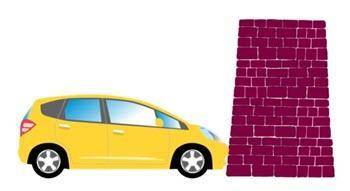
Physics, 28.06.2021 02:40 hesterkl1225
In the picture below, a car hits a wall. Using what you know about Newton’s Third Law, which is true?
The force of the wall on the car and the car on the wall are equal
The force of the wall on the car is greatest
The force of the car on the wall is greatest
There is not enough information to tell


Answers: 1
Another question on Physics

Physics, 22.06.2019 20:30
We will use a video to study faraday’s law of electromagnetic induction by analyzing the induction that occurs due a coil of copper wire sliding along an air track that passes through an external magnetic field. specifically, we will: examine some of the main principles behind faraday’s law. apply lenz’s law to determine the direction of the induced emf. take measurements of the induced emf from the voltmeter as the coil passes into and out of the external magnetic field. use the horizontal scale provided to determine the speed of the coil. calculate the magnetic field induced in the coil as it passes into and out of the external magnetic field.
Answers: 2

Physics, 22.06.2019 23:00
The average time that it takes for the car to travel the first 0.25m is s. the average time to travel just between 0.25 m and 0.50 m is s. given the time taken to travel the second 0.25 m section, the velocity would be m/s.
Answers: 1

Physics, 22.06.2019 23:30
An electric power distributor charges residential customers $0.10 per kilowatt-hour (kwh). the company advertises that "green power" is available in 150 kwh blocks for an additional $4 per month. (green power is generated from solar, wind power, and methane sources.) if a certain customer uses an average of 391 kwh per month and commits to one monthly 150 kwh block of green power, what is her annual power bill
Answers: 1

Physics, 23.06.2019 02:10
Find the steady-state temperature at the center of the plate = /2, = /2) for sums of w from n=1 to n=19 (only odd values). find the value of n for which the change in /2, /2) is less than 1% from the value at the previous n. at this point, we consider the solution converged. does the value of the temperature at the center seem reasonable? in this part, the values of x and y are constant scalar values. you should produce a plot of the value of n on the horizontal and the estimate of the temperature at the center of the plate on the vertical. b. using the value of n (or larger) that resulted in convergence in part (a), create a contourf plot of the temperature distribution across the entire plate. use enough spatial subdivisions to create a useful plot. comment on the results. hint: you need to determine what “x” and “y” values to use to make your t matrix. i recommend using a different number of x and y values. use enough x and y values so that the plot is “smooth”.
Answers: 1
You know the right answer?
In the picture below, a car hits a wall. Using what you know about Newton’s Third Law, which is true...
Questions


Mathematics, 12.01.2021 21:20



Biology, 12.01.2021 21:20


Physics, 12.01.2021 21:20

Chemistry, 12.01.2021 21:20

Mathematics, 12.01.2021 21:20



Physics, 12.01.2021 21:20

Spanish, 12.01.2021 21:20


Mathematics, 12.01.2021 21:20

Biology, 12.01.2021 21:20



English, 12.01.2021 21:20

Mathematics, 12.01.2021 21:20



